Stirling (council area)
The Stirling council area (Scots: Stirlin; Scottish Gaelic: Sruighlea) is one of the 32 council areas of Scotland, and has a population of about 93,470 (2021 estimate).[1] It was created in 1975 as a lower-tier district within the Central region. The district covered parts of the historic counties of Stirlingshire and Perthshire, which were abolished for local government purposes. In 1996 the Central region was abolished and Stirling Council took over all local government functions within the area.
Stirling
Sruighlea Stirlin | |
|---|---|
 | |
 Coat of arms  Council logo | |
| Sovereign state | United Kingdom |
| Country | Scotland |
| Lieutenancy area | Stirling and Falkirk |
| Admin HQ | Stirling |
| Government | |
| • Body | Stirling Council |
| • Control | Lab minority (council NOC) |
| • MPs | |
| • MSPs | |
| Area | |
| • Total | 844 sq mi (2,186 km2) |
| • Rank | Ranked 9th |
| Population (2021) | |
| • Total | 93,470 |
| • Rank | Ranked 25th |
| • Density | 110/sq mi (43/km2) |
| ONS code | S12000030 |
| ISO 3166 code | GB-STG |
| Website | www |
The administrative centre of the area is the city of Stirling, with the headquarters at Old Viewforth.
The area borders the council areas of Clackmannanshire (to the east), North Lanarkshire (to the south), Falkirk (to the south east), Perth and Kinross (to the north and north east), Argyll and Bute (to the north and north west), and both East and West Dunbartonshire to Stirling's southwest.
The majority of the population of the area is located in its southeast corner, in the city of Stirling and in the surrounding lowland communities: Bridge of Allan and Dunblane to the north, Bannockburn to the immediate south, and the three former coal mining communities of Cowie, Fallin, and Plean, known collectively as the "Eastern Villages".
The rest of the council area's population is sparsely distributed across the rural, mainly highland, expanse in the north and west of the area. The southern half of this rural area comprises the flat western floodplain of the River Forth, bounded on the south by the Touch Hills and the Campsie Fells. North of the glen lie the Trossachs mountains, and the northern half of the council area is generally mountainous in character.
History
Stirling district was created in 1975 under the Local Government (Scotland) Act 1973, which abolished Scotland's counties, burghs and landward districts and replaced them with upper-tier regions and lower-tier districts. Stirling was one of three districts within the Central region. As created in 1975 the Stirling district covered five districts from Stirlingshire and four districts from Perthshire, which were all abolished at the same time:[2]
From Perthshire:
- Callander Burgh
- Doune Burgh
- Dunblane Burgh
- Western District, except Ardoch (which went to Perth and Kinross)
From Stirlingshire:
- Bridge of Allan Burgh
- Central No. 1 District
- Stirling Burgh
- Western No. 1 District
- Western No. 2 District
The new district and its neighbour Falkirk were together made a new Stirling and Falkirk lieutenancy area. The last Lord Lieutenant of Stirlingshire became the first Lord Lieutenant of Stirling and Falkirk.[3]
Local government was reformed again in 1996 under the Local Government etc. (Scotland) Act 1994, which abolished the regions and districts which had been created in 1975, replacing them with unitary council areas. Central Region was abolished and each of the area's three districts, including Stirling, became council areas. Stirling District Council was therefore replaced by the current Stirling Council.[4]
Governance
Stirling | |
|---|---|
 | |
| Leadership | |
Carol Beattie since 2018[6] | |
| Structure | |
| Seats | 23 councillors |
8 / 23 | |
7 / 23 | |
5 / 23 | |
2 / 23 | |
1 / 23 | |
| Elections | |
| Single transferable vote | |
Last election | 6 May 2022 |
Next election | 6 May 2027 |
| Meeting place | |
 | |
| Old Viewforth, Pitt Terrace, Stirling, FK8 2ET | |
| Website | |
| www | |
Political control
The first election to Stirling District Council was held in 1974, initially operating as a shadow authority alongside the outgoing authorities until the new system came into force on 16 May 1975. A shadow authority was again elected in 1995 ahead of the change to council areas which came into force on 1 April 1996. Political control since 1975 has been as follows:[7]
Stirling District Council
| Party in control | Years | |
|---|---|---|
| No overall control | 1975–1984 | |
| Labour | 1984–1988 | |
| No overall control | 1988–1996 | |
Stirling Council
| Party in control | Years | |
|---|---|---|
| Labour | 1996–1999 | |
| No overall control | 1999–2003 | |
| Labour | 2003–2007 | |
| No overall control | 2007–present | |
Leadership
The first leader of the council, Corrie McChord, had been the last leader of the Central Regional Council.[8] The leaders since 1996 have been:[9]
| Councillor | Party | From | To | |
|---|---|---|---|---|
| Corrie McChord | Labour | 1 Apr 1996 | 24 May 2007 | |
| Corrie McChord | Labour | 31 May 2007 | 12 Mar 2008 | |
| Graham Houston | SNP | 12 Mar 2008 | 17 May 2012 | |
| Corrie McChord | Labour | 17 May 2012 | 28 Feb 2013 | |
| Johanna Boyd | Labour | 28 Feb 2013 | 4 May 2017 | |
| Scott Farmer | SNP | 24 May 2017 | 19 May 2022 | |
| Chris Kane | Labour | 19 May 2022 | ||
Premises

The council is based at Old Viewforth on Pitt Terrace in Stirling. The oldest part of the building is a converted house called Viewforth, which had been built in 1855.[10] The house was bought by Stirlingshire County Council in 1931 for £5,250 and converted to become its headquarters.[11] A large art deco extension was added to the rear of the house, opening in 1937.[12] A new building called New Viewforth was built alongside the older premises in 1972, shortly before Stirlingshire County Council was abolished.[13]
Between 1975 and 1996 the premises at Viewforth served as the headquarters of Central Regional Council, whilst Stirling District Council was based at the Municipal Buildings at 8–10 Corn Exchange Road in Stirling, which had been completed in 1918 for the old Stirling Town Council.[14][15] On local government reorganisation in 1996 Stirling Council took over Viewforth. The 1972 building known as New Viewforth was demolished in 2014.[16]
Elections
Since 2007 elections have been held every five years under the single transferable vote system, introduced by the Local Governance (Scotland) Act 2004. Election results since 1995 have been as follows:[7]
| Year | Seats | SNP | Conservative | Labour | Green | Liberal Democrats | Independent / Other | Notes |
|---|---|---|---|---|---|---|---|---|
| 1995 | 22 | 2 | 7 | 13 | 0 | 0 | 0 | |
| 1999 | 22 | 2 | 9 | 11 | 0 | 0 | 0 | New ward boundaries.[17] |
| 2003 | 22 | 0 | 10 | 12 | 0 | 0 | 0 | |
| 2007 | 22 | 7 | 4 | 8 | 0 | 3 | 0 | New ward boundaries.[18] |
| 2012 | 22 | 9 | 4 | 8 | 0 | 0 | 1 | |
| 2017 | 23 | 9 | 9 | 4 | 1 | 0 | 0 | New ward boundaries.[19] |
| 2022 | 23 | 8 | 7 | 6 | 1 | 0 | 1 | Labour minority administration with Conservative support. |
Current composition
Following one change of allegiance since the 2022 election, the current composition of the council is:
| Party | Councillors | |
|---|---|---|
| Conservative | 8 | |
| SNP | 7 | |
| Labour | 5 | |
| Independent | 2 | |
| Green | 1 |
Wards
.svg.png.webp)
The wards are:[19]
| Ward Number |
Ward Name | Location | Seats |
|---|---|---|---|
| 1 | Trossachs and Teith |  |
3 |
| 2 | Forth and Endrick | 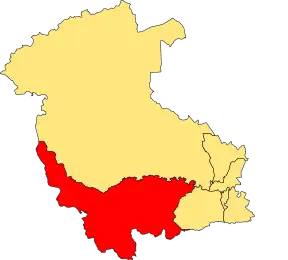 |
3 |
| 3 | Dunblane and Bridge of Allan | 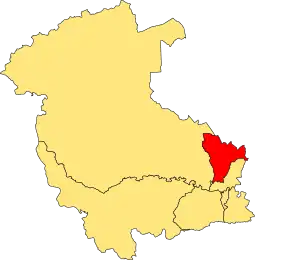 |
4 |
| 4 | Stirling North |  |
4 |
| 5 | Stirling West |  |
3 |
| 6 | Stirling East | 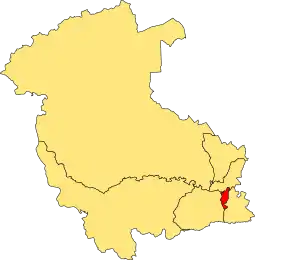 |
3 |
| 7 | Bannockburn |  |
3 |
Communities
The area is divided into 42 community council areas, all of which have community councils as at 2023.[20]
- Arnprior
- Balfron
- Balquhidder, Lochearnhead and Strathyre
- Bannockburn
- Braehead and Broomridge
- Bridge of Allan
- Buchanan
- Buchlyvie
- Callander
- Cambusbarron
- Cambuskenneth
- Carron Valley and District
- Causewayhead
- Cornton
- Cowie
- Croftamie
- Drymen
- Dunblane
- Fintry
- Gargunnock
- Gartmore
- Hillpark and Milton
- Killearn
- Killin
- Kilmadock
- King's Park
- Kippen
- Logie
- Mercat Cross
- Plean
- Polmaise
- Port of Menteith
- Raploch
- Riverside
- St Ninians
- Strathard
- Strathblane
- Strathfillan
- Thornhill and Blairdrummond
- Throsk
- Torbrex
- Trossachs
Settlements
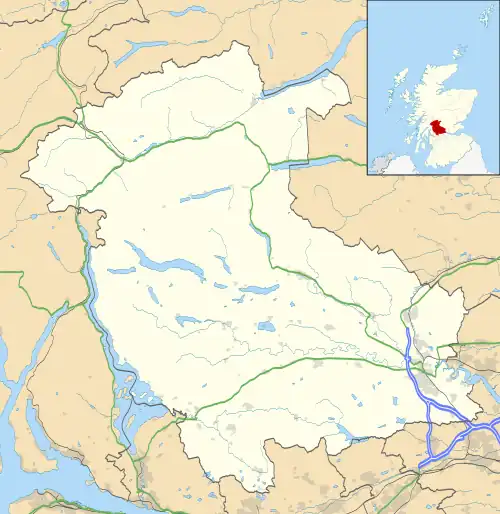
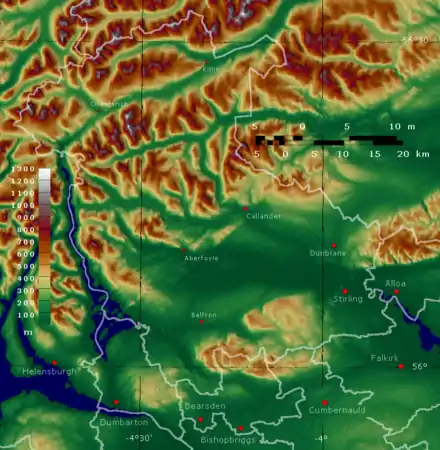
As well as the city of Stirling itself, there are many towns, villages and hamlets spread across the council area, as well as dispersed settlements.
Largest settlements by population:
| Settlement | Population (mid-2020 est.)[21] |
|---|---|
| Stirling |
37,910 |
| Dunblane |
9,310 |
| Bannockburn |
6,720 |
| Bridge of Allan |
5,320 |
| Callander |
3,080 |
| Fallin |
2,850 |
| Cowie |
2,720 |
| Doune |
2,200 |
| Balfron |
2,140 |
| Strathblane |
2,000 |
Villages
- Aberfoyle
- Ashfield
- Balfron
- Balmaha
- Balquhidder
- Blairlogie
- Blanefield
- Buchlyvie
- Cambusbarron
- Cambuskenneth
- Cowie
- Crianlarich
- Croftamie
- Deanston
- Drymen
- Fallin
- Fintry
- Gargunnock
- Gartmore
- Killearn
- Killin
- Kinlochard
- Kippen
- Milton of Buchanan
- Lochearnhead
- Plean
- Port of Menteith
- Strathblane
- Strathyre
- Thornhill
- Throsk
- Tyndrum
Hamlets
Dispersed settlements
Places of interest
- Carse of Lecropt
- Culcreuch Castle
- Inchmahome Priory (a ruined Augustinian priory on an island in the Lake of Menteith, used as a refuge in 1547 by Mary, Queen of Scots)
- Breadalbane Folklore Centre
- Cambuskenneth Abbey (formerly the seat of the Scottish Parliament)
- Doune Castle
- Dunblane Cathedral
- Falls of Dochart
- Falls of Lochay
- Glen Dochart
- Glenfinlas
- Lake of Menteith
- Lecropt Kirk
- Loch Achray
- Loch Ard
- Loch Earn
- Loch Lomond and the Trossachs National Park
- Loch Katrine (The source of most of the drinking water for the city of Glasgow)
- Loch Rusky
- Loch Venachar
- Moirlannich Longhouse
- Queen Elizabeth Forest Park (run by Forestry and Land Scotland)
- Scottish Institute of Sport (on the grounds of Stirling University)
- Stirling Castle
- The University of Stirling
- The Trossachs
- Wallace Monument
- West Highland Way
References
- "Mid-Year Population Estimates, UK, June 2021". Office for National Statistics. 21 December 2022. Retrieved 18 October 2023.
- "Local Government (Scotland) Act 1973", legislation.gov.uk, The National Archives, 1973 c. 65, retrieved 16 April 2023
- "The Lord-Lieutenants Order 1975", legislation.gov.uk, The National Archives, SI 1975/428, retrieved 16 April 2023
- "Local Government etc. (Scotland) Act 1994", legislation.gov.uk, The National Archives, 1994 c. 39, retrieved 16 April 2023
- "Council minutes, 19 May 2022" (PDF). Stirling Council. Retrieved 16 April 2023.
- "Carol Beattie to remain as Chief Executive of Stirling Council". Stirling Council. 30 January 2023. Retrieved 16 April 2023.
- "Compositions calculator". The Elections Centre. Retrieved 16 April 2023.
- "Council dashes hopes of nursery petition parents". Stirling Observer. 10 November 1995. p. 17. Retrieved 20 April 2023.
- "Council minutes". Stirling Council. Retrieved 16 April 2023.
- Historic Environment Scotland. "Pitt Terrace, Viewforth (Stirling Council Offices), including entrance gateways and boundary wall to the west (Category B Listed Building) (LB48323)". Retrieved 16 April 2023.
- "New County Buildings". Falkirk Herald. 17 January 1931. p. 7. Retrieved 16 April 2023.
- "New County Buildings opened". Falkirk Herald. 8 May 1937. p. 4. Retrieved 16 April 2023.
- "Viewforth - Council Buildings Old and New". Stirling Archives. 4 May 2016. Retrieved 16 April 2023.
- Historic Environment Scotland. "Municipal Buildings, 8-10 Corn Exchange Road, Stirling (LB41105)". Retrieved 16 April 2023.
- "No. 23961". The Edinburgh Gazette. 29 March 1996. p. 798.
- "Former Stirling Council building will vanish within weeks". The Courier. 11 January 2014. Retrieved 16 April 2023.
- "The Stirling (Electoral Arrangements) Order 1998", legislation.gov.uk, The National Archives, SI 1998/3253, retrieved 16 April 2023
- Scottish Parliament. The Stirling (Electoral Arrangements) Order 2006 as made, from legislation.gov.uk.
- Scottish Parliament. The Stirling (Electoral Arrangements) Order 2016 as made, from legislation.gov.uk.
- "About Community Councils". Stirling Council. Retrieved 12 April 2023.
- "Mid-2020 Population Estimates for Settlements and Localities in Scotland". National Records of Scotland. 31 March 2022. Retrieved 31 March 2022.
External links
- Stirling Council official website
- Stirling (council area) at Curlie
